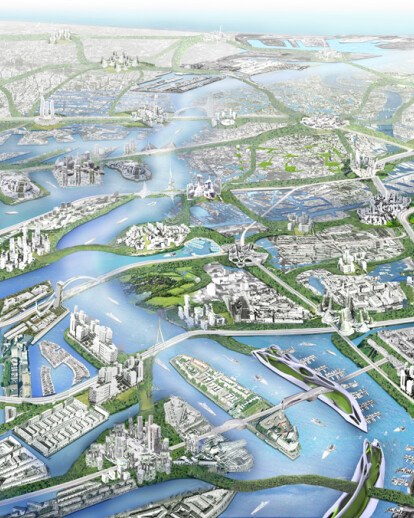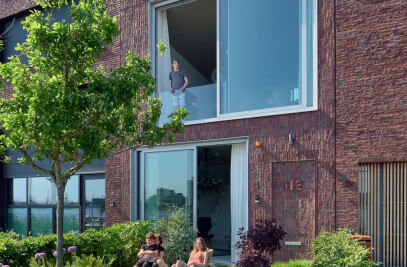The purpose of this study is to present a clear and comprehensive view on the various possible futures for the extremely long term (to 2100) for the urban area of Rijnmond-Drechtsteden, as input for the regional development of the Delta Scenarios.
There are four national Delta Scenarios developed (FULL, STEAM, CALM and HOT). The climatic and socio-economic changes are considered the main driving forces for the development of very different conditions for water management in the next century. The two key uncertainties of the Delta Scenarios are:
1. Will there be a moderate or rapid climate change?
2. Is there socio-economic growth or socio economic decline?
These uncertainties are also at the framework of the scenarios Rijnmond-Drechtsteden.
Full The development of the region will be based on the its accessibility profile. The zone of urbanisation from Amsterdam to Brussels can be seen as a vast network city. The nodes in this network are connected high-grade public transport. This transport also provides access to the intermediate recreational landscape. The modern tradition of programmatic segregation is obsolete. Living, working and recreation will be increasingly blended in the polycentric city. The harbour has returned to the city and the river is an integral part of the public space.
Steam Rijnmond - Drechtsteden serves as a port and manufacturing cluster in the metropolitan region of Amsterdam. In this densely populated region there are four urban centres, Amsterdam, Rotterdam, The Hague and Utrecht, which are linked to each other and to the main airport by means of heavy infrastructure (highways and high speed train. The harbour will continue to grow on the south bank of the river and disconnects further from the city. The river is mainly a part of the infrastructure needed for a smooth and efficient operation of the harbour and leaves no room for recreational use. The increasing threat of the water, makes it necessary that the city is well protected within the ring of dikes, but turned away from the water. The central business district accommodates businesses that are related to the port and trade. The public space in this centre is populated by sailors and traders looking for relaxation and entertainment. The urban area is further characterized by mono functional residential areas. The little remaining landscape can be used for recreation.
Calm The declining population was attracted to areas around nodes and cores with a concentration of amenities and public transport, well connected to other nodes. Because of the reduced population, there is literally more space in the city. People can have larger homes and larger lots. Not only does this benefit the housing comfort, but this space also allows for a more self-sufficient existence. Production of food and vegetation to convert into biomass for energy will mix with the housing and working environment on the scale of the building block. Clean technologies have also led that industry can take place within the city. The segregation of modernist urban planning has given way to a mixed city. Because of the reduced spatial claims over the surrounding countryside and the claim of navigation on the river, water and green strongly intertwined with the built environment.
Hot The city will exhibit many contrasts. There will exist spatial segregation between rich and poor but also between inside and outside the dikes. The rising water will force the city to give priority to the protection of the economically vital parts of the city and to loosen protection on the less vital parts of the urban fabric. The financial centre and the districts with a significant cultural and historical value are well protected behind dike ring fourteen and also the harbour will be well protected, because its economic importance. The parts that are frequently exposed to water will attract a new group of residents. Those who experience risks as a challenge will be attracted by cheap housing and the informal character of this part of town. In these parts there is room for creativity and experimentation, which will create a new cultural layer.

































